Content
Among all the plants and flowers used for vertical gardening, climbing roses have a special place. They are used to create various garden structures such as arches, gazebos, columns and pyramids. In addition, they are in perfect harmony with other flowers and can be planted in flower beds or flower beds. Climbing roses have different sizes and colors. Among this variety, it is simply impossible not to choose a variety to your liking. Below we will tell you about the best white varieties of this beautiful flower.
Climbing white rose classification
Climbing white rose, the varieties of which we will consider below, is an excellent representative of decorative garden types of roses. Except themselves garden roses, this also includes some species of climbing rose hips, which are a close relative of the rose.
In order not to become a victim of such sellers, it is necessary to carefully examine the young shoots of the seedling. In a regular rose hip, they will be bright green, while young shoots of a rose or garden rose hip will be colored dark red.
Climbing roses of white and other varieties are divided into two groups:
- climbers;
- ramblers.
Climbers are climbing re-blooming roses with large flowers and strong stems from 2 to 5 meters. Due to their height and erect shape, these varieties will require mandatory tying or direction to the supporting structure.
Rambler, also called curly roses, have more flexible shoots with a height of 5 to 10 meters. At the very beginning of their growth, the bush needs only to be directed in the desired direction, then in the process of growth it will cling to everything, paving the way in the indicated direction. This feature makes these varieties ideal for entwining arches and pergolas. Unlike climbers, these varieties are devoid of re-flowering. They bloom once a summer, but for several weeks and very abundantly.
Depending on this division, we will consider the best varieties of white climbing rose.
White climbers
These varieties are erect, so they are not suitable for entwining arches. But they can be successfully used for decorating walls, facades or gazebos.
Mrs. Herbert Stevens (Mrs. Herbert Stevens)
This beauty has been popular with gardeners and rose lovers for nearly 100 years. Its powerful bushes grow very quickly. Their maximum width will be 2.5 meters, and the average height will be about 4 meters. But under good conditions, the bushes can grow up to 6 meters in height. Rose varieties Mrs. Herbert Stevens is perfect for decorating a wall or fence. It is also often used to decorate the background of mixborders.
The beauty of the Mrs. Herbert Stevens is simply mesmerizing. Its thin, slightly thorny shoots with large light green foliage have multiple graceful flowers. Their color can be either pure white or slightly creamy. Maximum rose diameter Mrs. Herbert Stevens will be 10 cm. This wonderful beauty will bloom all season, filling the garden with the rich aroma of a tea rose.
Climbing rose variety Mrs. Herbert Stevens is distinguished by its unpretentiousness. This rose tolerates growing on poor and sandy soil well. But loamy soil with a neutral acidity level is best for her. The disadvantages of this variety include susceptibility to attacks by insects such as spider mites, caterpillars and leafhoppers.
Such treatments should be carried out during autumn or spring work, before the formation of buds and leaves.
Iceberg Climbing
This variety of white climbing rose is considered to be one of the best and most reliable varieties. It is prized for its particular landscape beauty. It was she who allowed the Iceberg Climbing rose to become the most bought among all the roses of the climber group.
Climbing rose bushes of the Iceberg Climbing variety will grow up to 2 meters wide and up to 3.5 meters high. Young bushes grow very quickly, so they can be planted near large walls or arches. On the powerful brushes of this variety, there are many double flowers that have a milky white color. In addition to its incredible beauty, Iceberg Climbing is distinguished by a pleasant sweetish honey smell. Iceberg Climbing blooms throughout the season.
The disadvantages of Iceberg Climbing include the fact that it can be subject to spotting and powdery mildew, especially if the summer turned out to be cloudy and rainy.
Mme Alfred Carrière (Madame Alfred Carrière)
Another brightest representative of the climber group. Roses of this variety were bred in France back in 1879, but are still in high demand.
The width of the Mme Alfred Carrière rose bush will be about 3 meters, but the height can vary from 2.5 to 5 meters. Tall shoots are erect and practically devoid of thorns. On them, among the large pale green foliage, bright white large flowers with diameters from 7 to 10 cm look very impressive, resembling a bowl with wavy edges in shape. Each cluster of long shoots of this variety can form from 3 to 9 buds. At the same time, at the very beginning, the buds have a pale pink tint, but when blooming they become white. The Mme Alfred Carrière variety exudes a rather strong floral scent, which is especially noticeable from a distance.
In our cold climate, Mme Alfred Carrière is the very first to bloom and blooms not only all summer, but also the first half of autumn. In warmer regions, this variety blooms for up to 12 months a year. This white rose can be grown in partial shade as well as in the sun. But in a sunny location, Mme Alfred Carrière will grow stronger and last longer than when grown in the shade.
A distinctive feature of the Mme Alfred Carrière rose is its undemandingness to the composition of the soil. In addition, it tolerates heat and humidity very well. She has good immunity, but in unfavorable years she can be attacked by powdery mildew.
White ramblers
The curly nature of the shoots of these varieties allows them to be used to entwine any structures, including arches and pergolas.
Bobby James
Among all ramblers, a special place is given to the Bobby James variety. This liana-shaped rose was bred in England about 50 years ago. It was there that her first popularity came to her. Today Bobby James is actively used to create romantic color compositions in gardens around the world.
Bobby James is called a liana-shaped rose for a reason. Its shoots grow up to 8 meters in length and can entwine everything in its path: from a small arch to a garden tree. The bushes of this variety are vigorous and rather thorny. On them there are numerous bright green elongated leaves. After flowering begins, which will last until the end of July, it becomes extremely difficult to see the foliage of Bobby James. After all, all attention to themselves is riveted by armfuls of milky-white small flowers with golden-yellow cores. Their shape slightly resembles cherry blossoms, and their diameter will be about 5 cm. On each brush, from 5 to 15 double flowers can be located at the same time. This rose has a rich aroma that slightly resembles musk.
Considering the size of the white rose of the Bobby James variety, for planting it is worth choosing only free places with strong supports. Otherwise, the rose will have nowhere to grow, and it will begin to wither. Due to its frost resistance, Bobby James is excellent for growing in our climate.
Rector
The origin of the climbing rose variety Rector is still debated. According to one version, Rector is an old Irish variety that was found in one of the gardens of this country and renamed. According to another version, the Rector is the result of an accidental crossing of white climbing rose varieties in the Irish nursery Daisy Hills.
The width of the pale green Rector rose bushes will be 2 meters, but the height can vary greatly from 3 to 6 meters. This variety will endure any gardener idea. They can be wrapped around columns and arches, run up the wall and even cut off, growing like a bush.
Rector has a very lush flowering. Each brush has from 10 to 50 semi-double flowers of small size. Immediately after opening, the flowers are creamy white with bright golden stamens. But in the sun they fade to a snow-white color, and their stamens turn brown. The scent of this rose is unobtrusive with predominant notes of musk.
Rector is winter-hardy and very resistant to rose diseases. But in a rainy summer, powdery mildew can appear even on it.
Snow Goose
This climbing rose is remontant, which means that after the main flowering it can bloom again. If summer is hot, then Snow Goose will bloom until autumn.
The Snow Goose variety has a standard width of 1.5 meters for roses and a height of 3 meters. Most often, Snow Goose is used to entwine arches or other structures. But this variety can also be used as a ground cover plant.
The branchy bushes of the Snow Goose rose are practically thornless. Their dark green foliage is quite small and shiny. During the flowering period, the bushes are covered with small creamy white flowers, which fade in the sun to a snow-white color. The flowers of this variety do not look like a rose or a rose hip. Due to the many narrow petals of different lengths, they rather resemble daisies. Snow Goose blooms very profusely. On each of its clusters, from 5 to 20 flowers with a diameter of 4 to 5 cm can form. The aroma of this rose variety is light, unobtrusive and slightly sweet.
Snow Goose has medium powdery mildew resistance. But on the other hand, he winters well and does not require special care.
Climbing roses of white varieties will bring tenderness, lightness and romance to the garden. In order for their landing to be successful and growth to be good, we recommend that you familiarize yourself with the video:
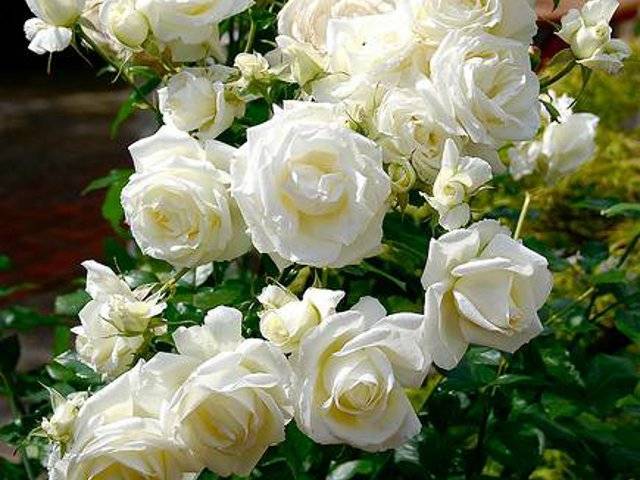
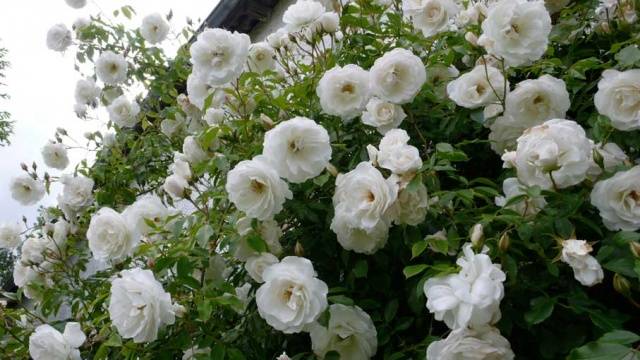

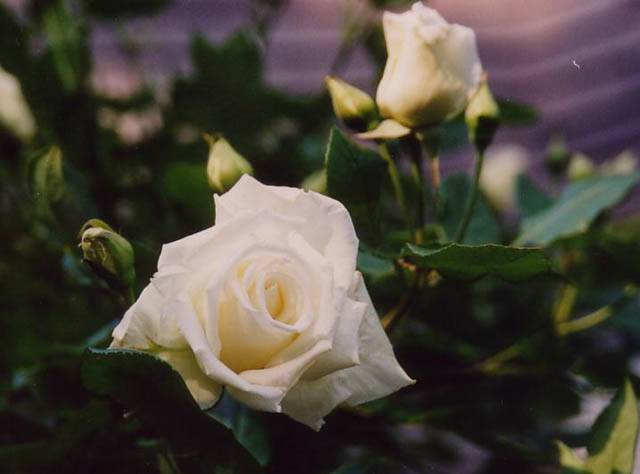
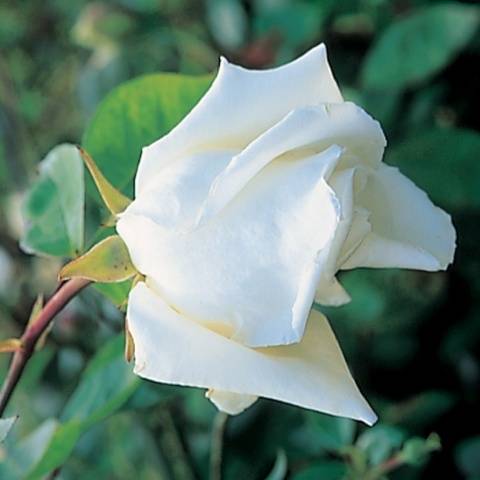

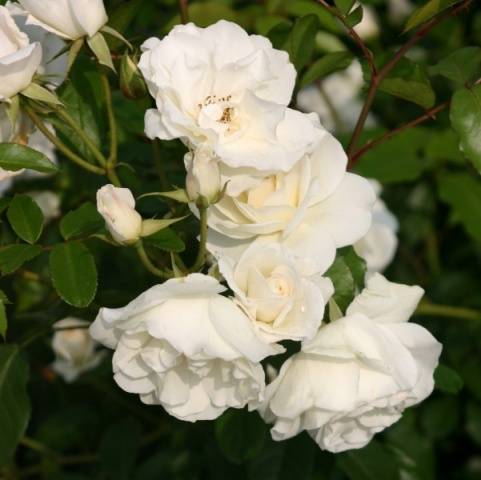

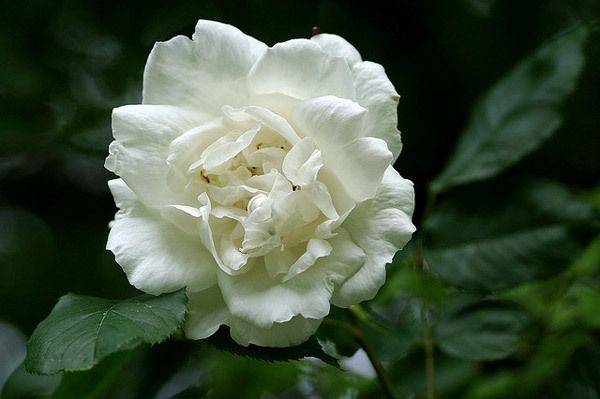



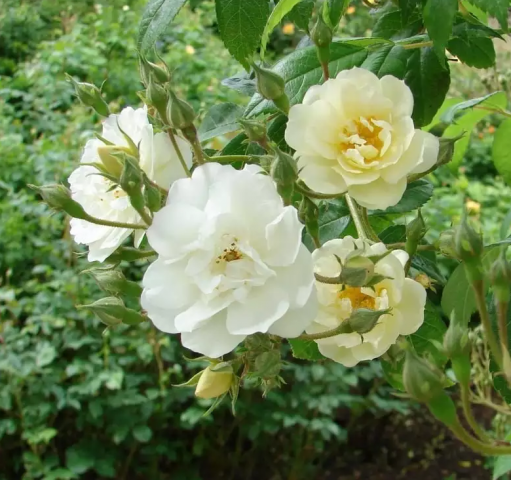
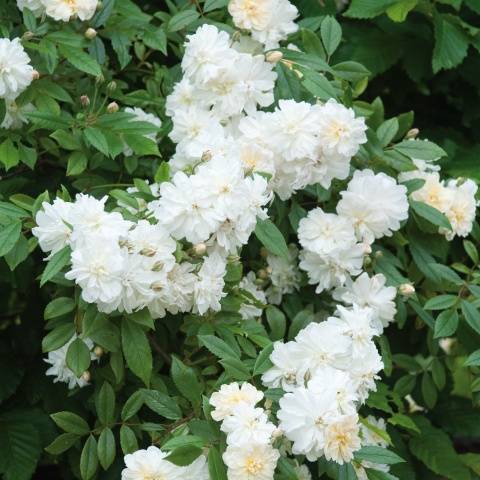
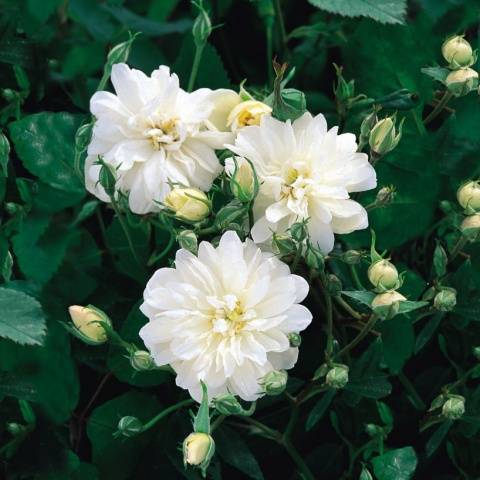









Good day. I have a climbing rose in my garden, but I don't know which variety. The flowers are white with pink, 7-8 cm with a delicate aroma. Powerful shoots, about 4 meters long, very prickly, over the summer they grow and spread in different directions. I don't even know how to care for her, whether to cut off the shoots and whether to cover her for the winter?
Good day!
It is extremely difficult to determine the type of rose according to your description. To determine the variety, high-quality photos are needed during the flowering period, as well as the flowering phase, how many times a rose blooms during the summer. It is of great importance whether the rose is self-rooted or grafted.
If this variety is own-rooted (that is, it was rooted from a cuttings of this particular variety), then the description may also coincide with any variety. But if this is a grafted seedling (cuttings from different varieties are grafted, most often on rose hips or other varieties of roses), then it will be extremely difficult to determine the variety. The reason is that grafted roses do not fully retain varietal qualities and they can change over time.
For example, if you graft a stem of Madame Alfred (a weakly studded variety) on a rose hip or another variety of roses, the flowers will look like Madame Alfred, but the shoots will be heavily studded. And the size and color of the inflorescences may change. That is, such a hybrid will combine both the qualities of the rootstock and the qualities of the scion. It is very difficult to predict the result.
It is imperative to cut climbing roses. Depending on the age, thickening and condition of the shrub, this will be a sanitary, formative or rejuvenating pruning. More information about pruning and covering climbing roses can be found in the article
https://gardens.decorexpro.com/en/tsvety/mnogoletniki/obrezka-na-zimu-pletistyh-roz.html
Whether it is necessary to cover roses for the winter depends on the growing region. In the southern regions of Russia, they are not even removed from their supports or covered. In the middle lane, rose bushes are removed from the supports, wrapped in lutrasil (or other light material) and covered with spruce branches. In the northern regions, you need to be more careful about this event.
So when does the rose bloom MRS. HERBERT STEVENS?
Good afternoon, Alexandra!
It is extremely difficult to answer your question unambiguously for several reasons. The flowering of Mrs. Herbert Stevens depends on adherence to the rules of care and climatic conditions. Particularly affect the abundance and frequency of flowering correctly drawn up schedule of fertilizing and watering. But the main difference between this variety is long, wave flowering. That is, Mrs. Herbert blooms throughout the season. But the flowering is undulating. It can bloom 3 to 5 times per season. In warm autumn, the buds adorn rose bushes almost to the very frost.
We wish you high yields!